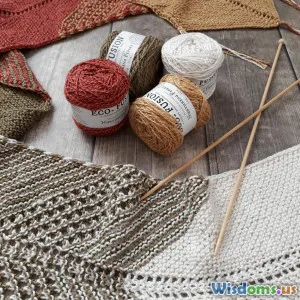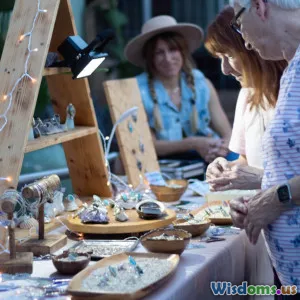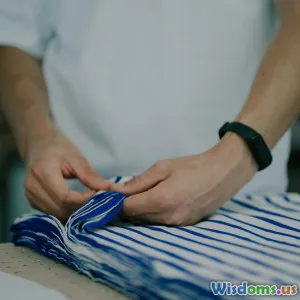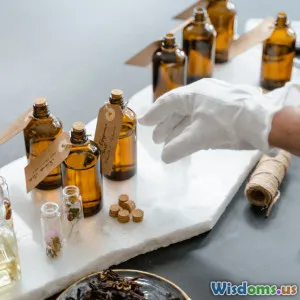
Crafting with Nature: Sustainable Materials
7 min read Explore the art of crafting with nature using sustainable materials to create beautiful, eco-friendly DIY projects. (0 Reviews)
Crafting with Nature: Sustainable Materials
In an era where sustainability is more than a buzzword, crafting with nature stands out as a powerful way to merge creativity with environmental consciousness. Imagine transforming fallen leaves, driftwood, or even recycled natural fibers into stunning handmade projects that not only tell a story but also tread lightly on our planet. Crafting with sustainable materials isn’t merely an eco-friendly choice—it’s a doorway into richer, more meaningful artistry.
Why Choose Sustainable Materials for DIY Projects?
The crafting world has long celebrated creativity and self-expression. However, the environmental impact of crafting—waste production, use of plastic-based materials, and non-biodegradable supplies—often goes unacknowledged. Choosing sustainable materials fosters responsible consumption with profound benefits:
- Environmental Preservation: Using renewable, biodegradable, or recycled materials reduces waste and pollution.
- Resource Efficiency: Sustainable materials often require less energy and water to produce.
- Healthier Crafting: Natural materials like organic dyes or untreated woods reduce exposure to harmful chemicals.
For example, artisans in Scandinavian countries have embraced crafting with reclaimed wood—not only reducing deforestation but also creating unique designs imbued with history.
Key Sustainable Materials for Crafting
1. Natural Fibers
Cotton, hemp, jute, and linen are widely recognized natural fibers—biodegradable and often sourced from renewable crops. Moreover, organic and fair-trade certifications ensure sustainable agricultural practices.
- Example: Hemp is notably resilient, requiring minimal pesticides and water compared to conventional cotton. DIYers use hemp for weaving, macramé, and eco-friendly bags.
2. Reclaimed Wood and Bamboo
Wood adds warmth and texture to handmade projects, especially when salvaged or harvested sustainably.
- Reclaimed Wood: Using wood salvaged from old buildings, pallets, or driftwood prevents deforestation and gives unique character to items like frames, shelves, or coasters.
- Bamboo: Fast-growing and renewable, bamboo serves as an excellent material for small household décor, utensils, and jewelry.
3. Plant-Based Dyes and Paints
Synthetic dyes contribute to water pollution and contain harmful chemicals. Conversely, plant-based dyes derived from indigo, madder root, turmeric, and beetroot are biodegradable and provide beautiful, earthy tones.
- Example: In India, artisans create vibrant textiles using turmeric’s golden hues, rooted in decades of sustainable practices.
4. Natural Clay and Stone
Earth-based materials like clay and stone provide a return to origins. Pottery made from natural clay or decorations carved from river stones resonate with a grounded, tactile artistry.
- Insight: Eco-friendly kilns and non-toxic glazes now enable potters to adopt more sustainable firing methods.
5. Upcycled Natural Materials
Upcycling embodies sustainability at its finest—transforming what might have been waste into treasures.
- Leaves can be pressed into colorful bookmarks or used in natural paper-making.
- Pinecones, seed pods, and feathers can be incorporated into festive decorations or jewelry.
Crafting Techniques That Honor Sustainability
Sustainable crafting requires thoughtful techniques that reduce waste and extend durability.
Minimal Waste Cutting and Design
Planning cuts to fully utilize raw materials reduces offcuts and scraps. For instance, artisans designing woven baskets from natural fibers often aim for measurements that optimize every inch, minimizing unusable waste.
Natural Adhesives & Finishes
Avoiding synthetic glue and varnish enhances safety and biodegradability. Alternatives like starch-based paste, beeswax, or linseed oil finish are widely used:
- Beeswax lends water resistance to wooden objects while being non-toxic.
- Starch paste, made from wheat or corn, is a traditional glue ideal for paper crafts.
DIY Natural Dyeing
Learning to dye fabrics and yarns with plants fosters deeper connection to materials and colors:
- Extracting dye from onion skins or avocado pits offers accessible, exercise results.
- Mordants like alum lock in colors without harsh chemicals.
Inspiring Real-World Examples
Globally, artisans and crafters are pioneering innovative uses of sustainable materials:
- The Woven Project (USA): A collective transforming reclaimed Mexican leather and hemp into beautiful, sustainable accessories.
- Eco Marble Painting (Japan): Using natural pigments mixed with rice paste, artists create unique marbled papers without synthetic elements.
Studies show that consumers increasingly value sustainability. A 2023 Nielsen report indicated 73% of millennials are willing to spend more on sustainable products, signaling market alignment for eco-conscious crafting.
How to Start Crafting Sustainably
Gather Local Materials
Exploring your surroundings can unearth plentiful natural materials—fallen twigs, dried flowers, or soil for clay. This reduces carbon footprint associated with shipping materials.
Educate Yourself
Researching sustainable certifications, such as FSC (Forest Stewardship Council) for wood or GOTS (Global Organic Textile Standard) for fibers, empowers conscious purchases.
Start Small and Experiment
Integrate sustainable fibers or natural dyes into existing projects. Experiment with simple upcycled materials before scaling complexity.
Document and Share
Sharing your creations and knowledge can inspire others—consider blogging, workshops, or community craft swaps.
Conclusion
Crafting with nature and sustainable materials transcends hobbyist activity—it becomes an act of mindful stewardship and artistic integrity. By choosing renewable fibers, reclaimed woods, natural dyes, and upcycled components, DIY enthusiasts can create not only beautiful objects but also a more sustainable future. Each piece tells a story of nature's bounty, environmental respect, and creativity unbound. Embark on this journey today, and transform your crafting into a powerful catalyst for change.
“Sustainability is no longer about doing less harm. It’s about doing more good.” — Jochen Zeitz
Take the first step: look around your home or neighborhood for your next sustainable crafting material. Nature awaits your creativity.
Rate the Post
User Reviews
Popular Posts




















